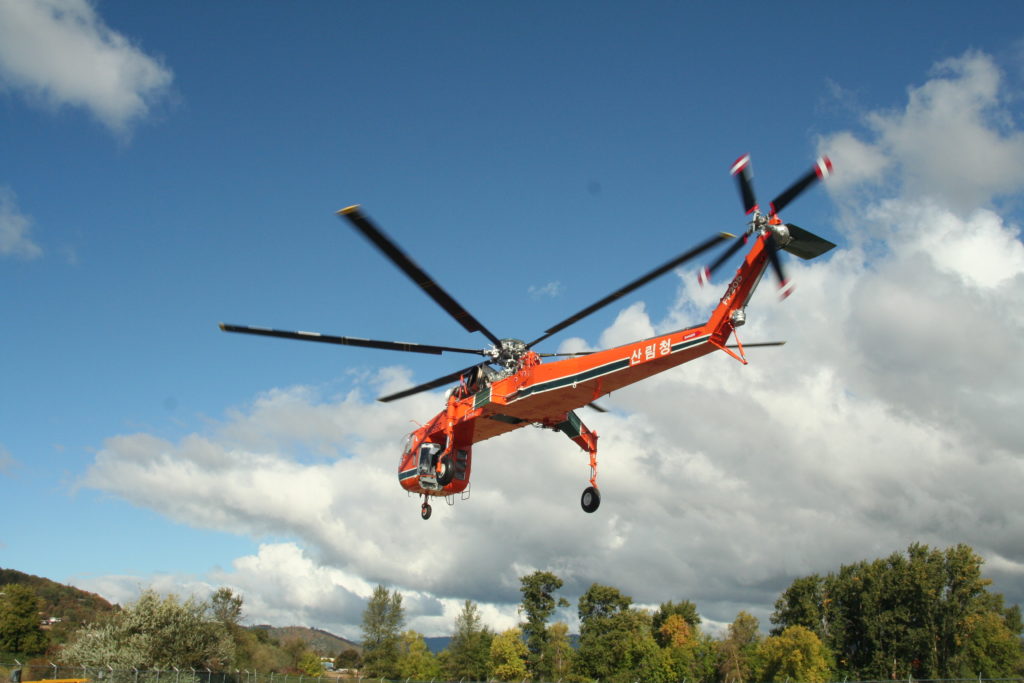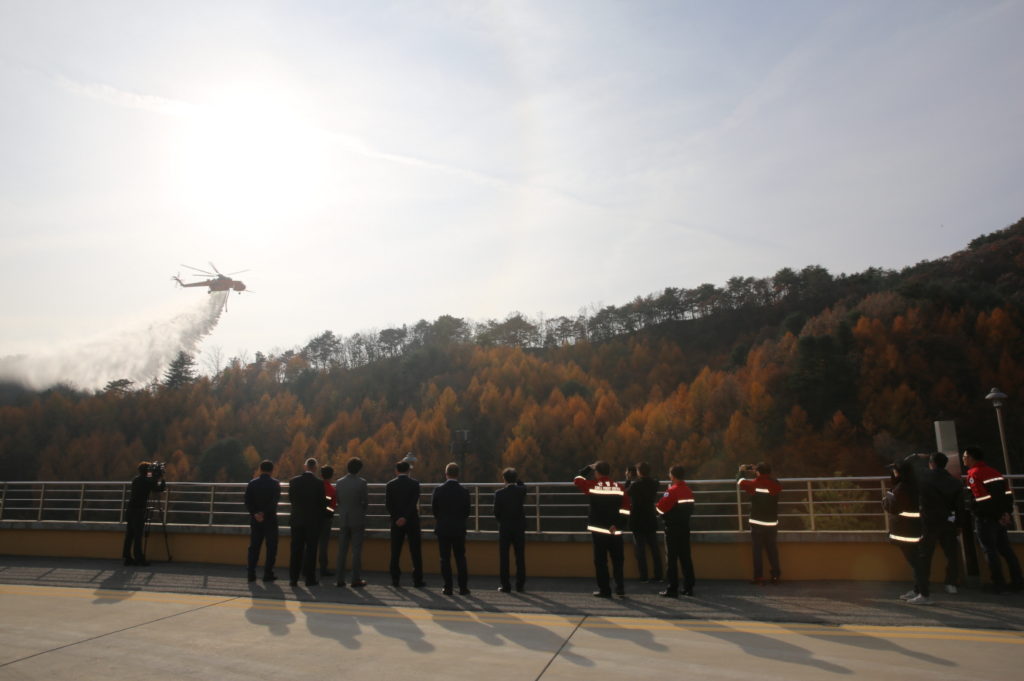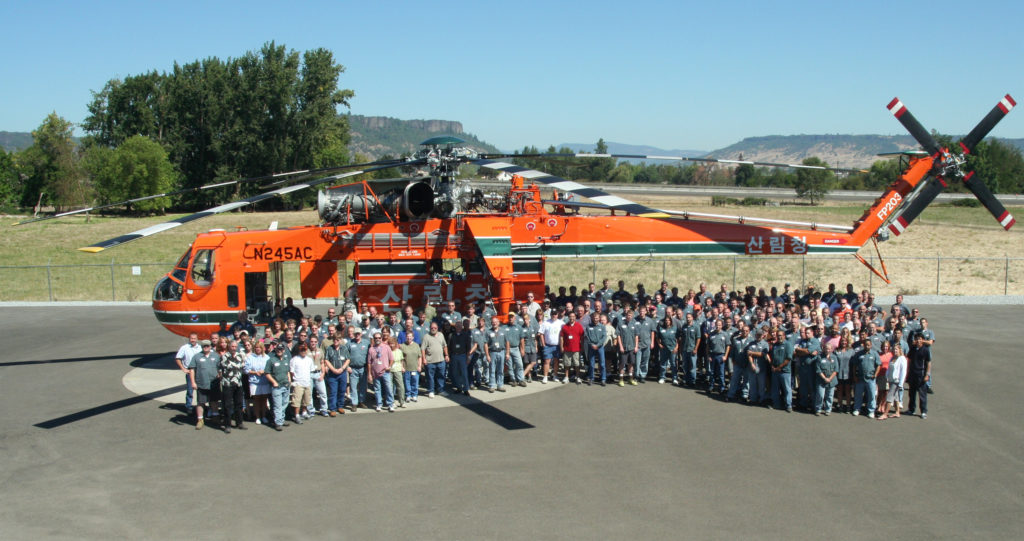Erickson Inc. has sold eight S-64 Air Crane® Helicopters to South Korea for aerial firefighting. The commitment includes trusted relationships and regular in-person visits and support.
By Jennifer Ferrero, published August 16, 2021
Portland, Oregon, the headquarters of Erickson, Inc., is a 12-hour flight from Seoul, Korea. Erickson’s Managing Director Asia Pacific Region, Hwan Kyu Chung, flies between the U.S. and South Korea about once per month. Chung speaks fluent Korean and has been traveling to the country since 2013. He said that Koreans prefer to do business in person, so he must travel to them, “Because of cultural differences, face-to-face meetings work better for them,” he said.
“Being an aviation professional was my dream job. It is my passion,” said Chung.

He added that traveling to Korea and other parts of the world has been a big part of his life since college. He has worked for Erickson in various countries. Chung earned a bachelor’s in aviation technology, is certified in airframe and powerplant (A&P), and is a private pilot for fixed-wing planes. With those credentials, Chung said he started as a manufacturing mechanic, traveled to Italy and Greece for heavy maintenance, and then went to Malaysia for three years.
Chung has been working double duty for years, supporting customers from a sales standpoint while working as a field mechanic. He shared that his training as a mechanic and the technical aspects of the job have helped him tremendously with customer interactions.
“They trust me because of my education and background,” Chung added.
Korea has been a long-time customer of Erickson’s and has bought a total of eight S-64 Air Crane® Helicopters over 20 years. Korea owns and runs the aircraft with its pilots and maintenance crews. However, as the worldwide leading operator, maintainer, and manufacturer of the utility helicopters, Erickson is happy to be on-hand to ensure that the Korea Forest Service (KFS) has success with the aircraft.
Success with the S-64 Air Crane® Helicopters renamed the K1 – K9 (omitting the K4 model due to superstition with the number four) in Korea, is mission-critical as fire is a significant hazard. Unfortunately, Chung will tell you that most fires are artificial, usually attributed to farmers who are not in control of their burns.

The helitanker has several unique features that make it best-in-class for wildland firefighting. The tanks can hold up to 2,650 gallons (10,000 liters (about the volume of a storage unit)) of water or retardant with foam injection capability. Additional equipment on the Air Crane® helicopter includes a pump snorkel or a ram hydrofoil sea snorkel, allowing for shallow water intake of either fresh or saltwater in 30 to 45 seconds.
Chung described South Korea as being like Oregon and Washington with green but heavily forested areas with much underbrush. The population of South Korea is over 51 million as of 2021.
Chung shared that aviation regulations are different in Korea than in the U.S.
In the U.S., we rely on the Federal Aviation Administration (FAA) for rules, safety charters, and certifications, South Korea’s equivalent is “The Korea Office of Civil Aviation (KOCA). It is subordinate to the Ministry of Land, Infrastructure, and Transport (MOLIT),” according to Wikipedia. Chung said that safety and operation rules are from Korean Air, a commercial airline organization. In the U.S., the FAA offers a more specific approach to differences between commercial fixed-wing aircraft operations and helicopters, for example.
The regulations, according to Chung, are essential to Erickson. While the Korea Forest Service operates the aircraft, Erickson guides the best possible use case scenario for KFS. The South Korean Pilots can choose from eight different computerized coverage drop levels to maximize each fire condition’s suppression effect. After removing the tank, the aircraft can be re-configured for other missions within hours.
“We want to see the aircraft flying and not just sitting on the ground, and we want to help customers to use the product. It is important to the company. We want to help them succeed with the Air Crane® Helicopter,” Chung said.
Troy Neimeyer, product and technical support manager for Erickson Inc., also travels to Korea quite often. Neimeyer said that while he is not a pilot, he can obtain technical information from Erickson’s pilots and mechanical staff when needed to answer questions for the customer.

Neimeyer lives on-site at the Wonju base in temporary housing when in Korea. The agreement with Korea means that Erickson supplies on-site support for at least six months of the year during fire season. He said that the Koreans are very hospitable, always welcoming. “I was reading about South Korea regarding hierarchy and harmony, and there is a tremendous amount of respect for elders and people with important titles. They are very respectful; they are genuinely nice people.”
Another activity that Neimeyer does when in Korea is hiking. He said he finds others that work at the base or in support of the aircraft, and they scope out trails to visit on the weekend. He said that camping is also popular in Korea, as is going to the beach.
Neimeyer and Chung both cited the quality of the food and that whenever Erickson staff comes to Korea, they enjoy healthy food. Neimeyer added, “The food is insanely great; all the food is amazing and healthy. Korean is an unknown food culture in America.” But he said that Korean food is fresh, “You eat a lot of fresh vegetables,” he added.
Chung echoed that most of the employees that travel to Korea to support the aircraft are fond of the food and hospitality in the country. “People going there for maintenance and training like it. The food is authentic and spicy,” he said. He added that everyone welcomes the crews when they come to town to troubleshoot an issue.
Erickson is proud to have sold so many of its S-64 Air Crane® Helicopters to Korea and to be able to supply ongoing, in-person support to their pilots and crews.

